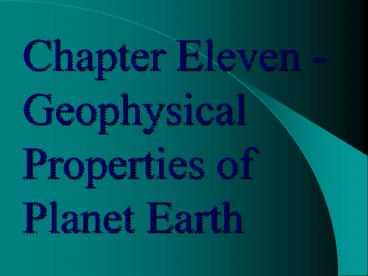MYSTERIES OF PLANET EARTH - PowerPoint PPT Presentation
1 / 35
Title:
MYSTERIES OF PLANET EARTH
Description:
Chapter Eleven - Geophysical Properties of Planet Earth – PowerPoint PPT presentation
Number of Views:120
Avg rating:3.0/5.0
Title: MYSTERIES OF PLANET EARTH
1
- Chapter Eleven -Geophysical Properties of Planet
Earth
2
HOMOGENOUS EARTH
3
Exploring the Interior of the Earth
- Geophysics- the study of the foundational
properties of the Earths interior. - Geophysicists- identify thickness, density,
composition, structure and physical state of the
layers of the Earths interior - Knowledge of Earths interior comes mainly from
seismological station that records seismic body
waves. - Analysis of waves arrival time recorded by
seismographs - Seismic tomography- using same principles similar
to CAT Scans to generate 3-D images of the
Earths interior - P-wave travels through solid and liquid while
S-wave travels only through solids - Refraction and reflection occur at contacts
between different layers
4
Earths Interior
- Inaccessibility of Earths Interior
- Deepest hole drilled 13 km
- General observations about Wave Propagation
- P waves compress mail material through which they
travel Medium returns to original volume Travel
through sold (Elastic) faster than Liquid or Gas
(inelastic) - S waves travel as shear waves admitted by
elasticity of solids omitted by inelasticity of
liquid or gas seismic wave velocity increases
with depth
5
Earths Layers
- Earth is divided into continental and oceanic
crust between different composition thickness
structure - Seismic discontinuity- MOHO- boundary between
crust and mantle Transitional zone
within the mantle (slowing) - Crust- silica rich igneous/metamorphic rocks-
continental 20-70 km (12.5-45 mi) 2.7-3g/cm3
oceanic- density 3.0 gm.cm3 - Mantle- upper 3.3 g/cm3 up to 400 km and more.
Lower P velocity at boundary between mantle and
core 700-2900 km (440-1800 mi) - Asthenosphere-region (100-350 km (62-217 mi))
where P S slow down - Seismic discontinuity- mantle core
6
Earths layers-contd.
- Crust composed of Silicate-rich igneous rocks
- Sampled directly by drilling
- Studied extensively by seismic analysis
- P-waves 6 km/s in continental crust 7 km/s
in oceanic crust - Continental Crust Thickness varies between 20-70
km P-wave velocity varies between 6-7 km/s
density 2.7-3.0 g cm-3 - Oceanic Crust Studied by Deep-Sea Drilling
seismic analysis 200-m deposit marine sed 2-km
layer of pillow sediment6-km layer of Gabbro
aver. Den. 3 g cm-3
7
Earths layers-contd.
- Crust-Mantle Boundary Moho discontinuity
- Mantle Density varies 3.3-5.5 g cm-3 composed
of elastic/plastic solids Changes in P- S-wave
velocities reveal mantle layers P-wave velocity
from Moho to Asthenosphere 8-8.3 km/s P-wave
velocity in Asthenosphere lt 8 km/s
Asthenosphere is partially molten because of
unique temperature and pressure combination - Transition Zone Below Asthenosphere At 400-km,
Mg olivine compresses to form spinel At 700-km,
spinel and other minerals change to metallic
oxides
8
Ultramafic mantle minerals collapsing
9
Earths Mantle-Core Boundary
10
Earths layers-contd.
- Lower Mantle 700-2,900 km deep P-wave velocity
from Asthenosphere to base of mantle 8.3-13.6
km/s composed of dense Mg silicates and oxides - Mantle-Core Boundary P-wave velocity slows from
13.6 to 8.1 km/s S-waves cease Outer core
Liquid Iron-Nickel mix, density 10-13 g cm-3 - CORE 1/6TH Earths volume, 1/3RD Of the Earths
Mass Pressure gt3 Million atmosph.
Temp.4,700ºC Composition IRON-NICKEL,
Consistent with Seismic data, meteorite data, and
mathematical model
11
Velocity Change between layers
12
Three major components of the Earth
13
Seismic Wave
14
The low-velocity zone
15
Shadow Zones
- Shadow zones-
- segments of the earth opposite an Earthquakes
focus where no direct S P waves can be received - S-Shadow zone-
- produced because shearing S-wave cannot travel
through liquid, hence S-Shadow zone occurs - P-Shadow zones-
- are produced as P-waves are refracted when they
enter a zone of lower rigidity - both zones help to confirm that earths outer
core is liquid
16
Shear Waves Shadow zone
17
Shear Waves contd.
18
P-Waves Globe
19
P-waves Cut-away
20
The Behavior of P- and S-waves
21
Solid Inner Core
22
Gravity
- Force of attraction that an object (A) exerts on
another object (B), i.e. Force of gravity is
proportional to - mass of A x mass of B
- distance 2
- Gravimeter- measures variation in Earths
gravity. - Gravity depends on the altitude of the land,
latitude, and distance from the Earths center of
gravity. - Gravity anomalies-
- difference between actual gravimetric measurement
to the expected theoretical values- positive
attraction will be lower than expected and
negative attraction higher than expected
23
Gravitation attraction of the earth
24
Gravitation-contd.
- Isostacy- equilibrium between lithospheric
segments and the asthenosphere beneath them - Magnetism- force associated with moving charged
particles that enables certain substances to
attract or repel similar materials- magnetic
reversal, paleomagnetism
25
Negative Gravity anomaly
26
Positive Gravity anomaly
27
Positive gravity anomaly over ore deposit
28
Principle of isostacy - icebergs
29
Principle of isostacy - mountains
30
Isostatic adjustments
31
Magnetic field of a bar magnet
32
Prevailing Magnetic Field
33
Electrically conductive field
34
Magnetic field polarity within magnetite
35
Terrestrial record of magnetic reversal































